Why Plant Wildflowers
Wildflowers are able to survive without human help, unlike many of their domestic horticultural competitors. Some species like the 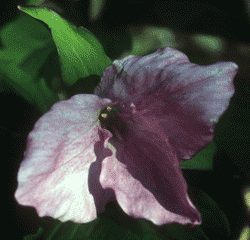 Trilliums and Mitchella are adapted to grow in dense shade, others in very wet soils (Lobelia and Caltha), conditions that are worse than most plants would tolerate. Wildflowers grown within their natural habitat or native range are often fine tuned to climatic conditions, and will self-sow (Aquilegia). Trilliums and Mitchella are adapted to grow in dense shade, others in very wet soils (Lobelia and Caltha), conditions that are worse than most plants would tolerate. Wildflowers grown within their natural habitat or native range are often fine tuned to climatic conditions, and will self-sow (Aquilegia). Outside of their habitat they behave as exotics and their culture is the same as other horticultural cultivars. Annual seed mixes may produce an attractive display in their first year. If components of the wildflower mix do not match local conditions some species will fail to set seed, and drop out of the mix in following years. Outside of their habitat they behave as exotics and their culture is the same as other horticultural cultivars. Annual seed mixes may produce an attractive display in their first year. If components of the wildflower mix do not match local conditions some species will fail to set seed, and drop out of the mix in following years.
Where to obtain plants - Where not to obtain plants is easier to express. Don't take plants from the wild, unless it is from the path of a bulldozer. Of the 20,000 native plant species in North America 3,000 are threatened or endangered, mostly due to habitat loss. One reason for using Native plants in home and public gardens and along roadways is to provide a reservoir so that the genetic make up of these threatened species is not lost. The hope being that at a future date they could be returned to the wild.
Many perennial species have spreading roots or rhizomes, and transplant poorly since a large portion of the root is lost in transplanting. Nursery grown material normally yields the best results since the entire root is in the pot. Try to buy plants that have been propagated, not collected. Try to purchase stock that was raised locally, for it is more likely to be fine tuned for the environment in which you live. Members of native plant societies often raise plants from locally collected seeds and have sales of their surpluses.
Collection of seed from the wild, provided that all the seed produced is not taken, is one of the best ways, but also the most work. Seed can be purchased, but for many species it should be planted as soon as possible after it is removed from the plant. If you collect seed, don’t forget to ask the landowner's permission. Check to see if the seeds require cold treatment for germination. Broad ranging species like black-eyed Susan, Rudbeckia hirta, are likely to be forming local ecotypes, populations of plants adapted for local climate extremes and day length. Seeds from plants taken from the northern edge of a species range would not do well at the southern extreme and would, via pollination, contaminate local populations with traits not suited for a given climate.
Wildflower Gardens
Planting a wildflower garden can be an attempt to get all of the eggs out of the same basket; to move wildflowers from the wild to a protected space. The problem has been that we have tended to take all of the eggs out of natures basket. Many species of wildflowers are slow growing, possibly taking 7 years from seed to first flower. We tend to want instant gratification. So if you see blooming trillium for sale at roadside stand they were either removed from the natural ecosystem, or raised for seven years before sale. Realistically, what do you think? Yes, if you purchase the plant, it had already been dug up, but will it survive to reproduce in your yard? The question is not if it will live, but will it be able to successfully reproduce and spread? Was the colony from which it was dug so disturbed that it will not come back even though a few plants were left? Does the plant have a dependant relationship with soil microorganisms that are not present in your own soil?
Quality plants that have been grown from seed or from cuttings of nursery stock are increasingly becoming available. Many chapters of the Native Plant Society will have yearly sales of the plants their chapter members have raised from seed or propagated. These may be guiltlessly purchased. Seeds can be collected from nature, and several good books exist on the post harvest treatment of seeds. For success you need the soil to match the soil of the parent, and a bed that approximates the light and humidity conditions from which it was taken.
There are several good sources for transplants; from colonies that friends have established in their own yards, or seedlings within your own colonies, or as a plant rescue from in front of a bulldozer. Woodland housing development or new road construction provides great opportunities for plant rescue, for the plants will not survive if left in place. If you are doing this, be aware that some plants have very fine and extensive root systems, and that after planting extra leaf litter and moisture may be needed to counteract the damage that their roots have sustained.
You can consider your garden to be a success when your plants begin to spread, either on their own, or as a result of collecting their seed and growing new plants from it.
A list of books on the subject of wildflower cultivation follows the notes on specific species.
Cultivation notes on selected Wildflower Species
1. Rue-Anemone Thalictrum thalictroide
 Family: Buttercup (Ranunculaceae) (ran-nun-kew-LAY-see-ee) Family: Buttercup (Ranunculaceae) (ran-nun-kew-LAY-see-ee)
Habitat: Well-drained humusy soil neutral to slightly acid, part shade .
Description: Several 1/2 inch white to pale pink flowers with prominent yellow stamens, 4 to 8 (6 to 12) inches tall, leaves small three-parted.
Bloom period: spring. May and June edge of a shady garden
Culture: Flowers are long lasting (four to six weeks) and foliage is decorative, resembling meadow rue. Dries up neatly in mid summer. Will self-sow in the right situation. Grows from a cluster of tiny tubers. To promote extra foliage water in late spring if the weather is dry. Note mice may decimate these plants.
Recommended selections: Pink, double, and semi-double forms, in addition to a double white are available. Schaaf's double pink is a recommended cultivar who's blooms last a month.
Propagation: Division of tubers in the summer after the foliage dies is not always successful. Nursery stock recommended, since tubers must each have an eye. By seed, seeds must be planted as soon as they ripen, and will take three years to flower.
Planting Depth and Spacing: Plant tubers 1 inch deep, and space 4 inches apart, or in clusters.
Back to List
2. Wild Columbine or Eastern Columbine Aquilegia canadensis (ak-wi-LEE-jee-a kan-ad-DEN-sis)
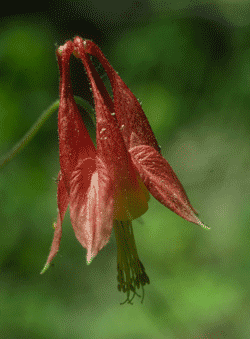 Family: Buttercup (Ranunculaceae) Family: Buttercup (Ranunculaceae)
Habitat: Light, well-drained, not too rich soil, sandy loam preferable pH 5-7, optimum 6-7; partial shade. Found on mountains and rock outcrops in wild .
Description: Hardy perennial, flowers (up to 2" across) with 5 long red spurs and yellow facea. Flower resembles five doves drinking, hence the common name (Columb=dove). Stems 1 to 2 feet in height with coarsely divided compound bluish-green foliage that is mostly basal. Columbines are attractive plants for Hummingbirds since they prefer red flowers.
Bloom period: May - July
 Related species: caerulea = Colorado Columbine, native to the Rocky Mountains is blue-purple and white. —chrysantha = Golden Columbine, native to Texas is yellow. —jonesi is an alpine form from Montana and Wyoming with large blue flowers on short (3") plants. Related species: caerulea = Colorado Columbine, native to the Rocky Mountains is blue-purple and white. —chrysantha = Golden Columbine, native to Texas is yellow. —jonesi is an alpine form from Montana and Wyoming with large blue flowers on short (3") plants.
Culture: Easy to cultivate, good in mass plantings, rock gardens or sunny borders. Use on slopes, banks, and against walls. Makes a good cut flower. Flowers slender compared to garden columbines, good hummingbird flower, and the basal foliage lasting until winter. Likes rocky situations were roots can get down to cool soil, needs good drainage. Depth of established rootstocks allows plant to survive periods of dry weather. In spots it likes it will self-sow on bare earth.
Propagation: By seeds which turn black when ripe. Transplant while still small, since old roots are deep seated and do not move readily, hence they are short lived when divided. Use Nursery stock, for collected stocks roots are too gnarled to be moved successfully. Seed needs to be stratified in cool moist soil or damp vermiculite, for 3-4 weeks at 40 F or below. Sow both the seeds and the vermiculite. Note seeds must remain on the surface since they require light for germination. Germination is best at 70-80 F and takes place within 3-4 weeks. Alternatively to cold stratification seeds may be planted in flats and left out of doors to over-winter. Easiest yet sow seeds where you want the plants to grow. Seeds take two years to flower.
Back to List
3.  Wild Ginger Asarum canadense Wild Ginger Asarum canadense
(a-SAR-um kan-ad-DEN-sis)
Heartleaf Asarum virginicum
Family: Birthwort (Aristolochiaceae) {Ar-rist-oh-loh-kee-ay-see-ee}
Habitat: Ginger is found on limestone ledges and humus rich soil on the acid side, pH 5-7.5, full shade. Native to Virginia to Georgia and Alabama.
Description: Both species heart-shaped leaves up to 3" across. Heartleaf has evergreen foliage often mottled with white, wild ginger has a velvety texture, both are only a few inches high. The leaves may be aromatic, and the aromatic rhizome has been used as a substitute for ginger. Petalless flowers, made up of deep red sepals with a white center are born on the ground at the base of the leaves. They are beetle/ant pollinated, and the white center makes the flower appear to be something an ant could crawl through. Ants disperse the seeds.
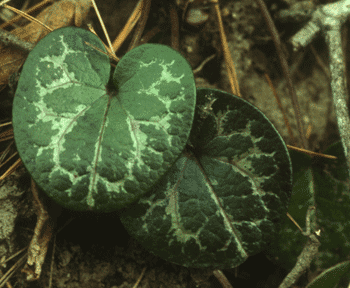 Bloom Period: Spring Bloom Period: Spring
Culture: Does well in dense shade, can be used as a ground cover under shrubs. Does best with plenty of humus that can retain moisture through periods of drought. Many other species can push up between their leaves making them an ideal ground cover.68
Recommended selections: Heartleaf ginger, Asarum virginicum and Shuttleworth's Ginger Asarum shuttleworthii forma 'Callaway' are evergreen unlike A. canadense with its lighter green velvety leaves. European ginger A. europaeum has been imported and also have a shiny evergreen leaf.68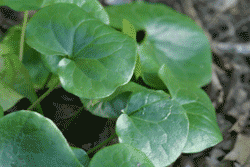
Propagation: By division in the spring. Root cuttings take easily in damp peat moss. Plant seeds 1/2" deep as soon as the fruits start to split and cover with leaf mulch.
Back to List
4. Fairy-Candle or American Bugbane Cimicifuga americana (sim-i-SIF-u-ga am-eh-rik-KAY-nuh)
 Family: Buttercup (Ranunculaceae). Family: Buttercup (Ranunculaceae).
Habitat: Deep woodlands, Rich, humusy soil; partial shade .
Description: White wands of flowers born on plants 2 to 4 feet tall. Twice compound foliage good as an accent.
Bloom period: Late summer. Makes a good accent plant that blooms after most woodland species. Smaller than Black Cohosh (racemosa) without C.r.'s oversweet odor.
Culture: Sun tolerance a function of moisture, fertile soil on the acid side, respond well to spring mulch. If exposed to direct sunlight several hours a day white spires will be crooked
Related species. Black Cohosh (C. racemosa ) grows to 3 to 8 feet depending on soil, therefore is suitable only for large gardens.
Propagation: Seed sown in fall, not easy, also by spring or fall root division. Does best when planted in the dormant state.
Back to List
5. Pink Bleeding-Heart Dicentra eximia (dy-SEN-tra ex-IM-ee-uh)
Family: (Papaveraceae Poppy Family)
Habitat: Moist, humusy soil on the acid side pH 4.5 - 5.5. Half Shade
Description: These are the North American relatives of the Bleeding Heart D. spectabillis was introduced from Japan. Our native bleeding heart has pink to rose flowers, fernlike foliage 12-20 inches tall.
Bloom period: Spring to hard frost - long bloom period
Culture: Bebe Miles states "If you have room for but one plant in a shady garden, this eastern species ... should be your choice. Few perennials from any part of the world can match their long flowering season."67 To encourage long blooming season use plenty of peat moss and mulch with pine bark so that the plants never lack for moisture. Needs some sun, but shade at midday.
Related species: D. formosa D. oregana are western species. Cultivars are available. D. cucullaria (Dutchman's-breeches) has cream-white flowers resembling 4 to 10 pairs of miniatures pantaloons hung upside down to dry. The flowers are fragrant and last 1 - 2 weeks. Its seeds are ant dispersed. Since it goes dormant after spring it is not widely used. D. canadensis or squirrel corn is named for the small tubers that resemble corn and are favored by both mice and squirrels. It grows to a foot, with finely divided foliage, flowers fragrant and heart shaped, greenish white touched with purple. Like Dutchman's breeches squirrel corn disappears soon after flowering.
Propagation: First look for seedlings around parent plants. By seed sown in late summer where plants are to grow. They need 4 weeks cold treatment for germination. By 8-10 weeks the seedlings are large enough to move to small containers, four more weeks are required before transfer to the garden. Root division followed by fungicide treatment of the cut works well in early spring.
6. Green and Gold or Golden-Star Chrysogonum virginianum
(kri-SOG-o-num vir-jin-ee-AY-num)
 Family: Daisy (Compositae) Family: Daisy (Compositae)
Habitat: Native to open woods from S. Pennsylvania to Florida and Alabama. Well-drained, humusy soil; partial shade to full sun.
Description: Herbaceous perennial with long lasting star shaped yellow daisies to 2 inches diameter. Leaves hairy evergreen born on creeping stems. May form mounds to 1-2 foot. Excellent ground cover or rock garden plant, a long flowering plant for half-shady garden.
Cultivation: Needs a well-prepared garden soil fortified with leaf mold or humus. It will fare well on a dry clay road bank. Avoid the use of heavy organic mulches. Remove dead heads to prolong flowering. Once established it will spread from stolons and self-sow to form good sized patches. It is effective with spring bulbs.
Related Species: C. v. var. —australe has above ground stolons, it is not as showy as var. virginianum its spreading habit is best used on banks and rocky ledges.
Propagation: By seed or by division in spring. Spreads naturally by runners. Cuttings will root in sand and perlite medium.
Back to List
7. Great Merrybells Uvularia grandiflora (u-vew-LAR-ee-a gran-dif-FLOH-ruh)
Family: Lily (Liliaceae) Habitat : Well-drained, rich, neutral soil pH 6-7, partial shade.
Description: Clear lemon yellow nodding bells on arching forked stalks 1 to 2 foot (10 - 15" Sperka) tall; clasping leaves whose bases ring the stalk. Attractive all summer.
Bloom period: April to May
Culture: Needs a cool spot and good air circulation. Flowers dance in the slightest breeze. North side of buildings provide both shade and a source of lime to neutralize the soil. Separate when large clumps form, but replant quickly. Plant while dormant in early spring or fall. Grows from a pure white rhizome. If from seeds, sow soon after they are ripe, flowering will take three to four years.
Related species: Wild Oats (Uvularia sessilifolia ) described below and Perfoliate-leaved Bellwort (Uvularia perfoliata) (per-foh-lee-AY-tuh) which grows to 20 inches and has leaves neatly perforated by the stem. Perfoliate-leaved bellwort flowers are paler yellow than Great Merrybells.
Propagation: By seed collected from triangular capsules in the fall, sow quickly, and by division in spring or fall.
Back to List
8. 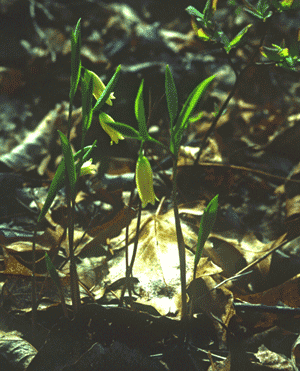 Wild Oats, Sessile Leaved Bellwort Uvularia sessilifolia (u-vew-LAR-ee-a sess-il-if-FOH-lee-uh) Wild Oats, Sessile Leaved Bellwort Uvularia sessilifolia (u-vew-LAR-ee-a sess-il-if-FOH-lee-uh)
Family: Lily (Liliaceae)
Habitat: Well-drained, rich in moisture retaining humus, neutral soil, partial shade. In nature colonizes in groups to form carpet on the woodland floor .
Description: Light yellow slender nodding bells on arching forked stalks 6 to 10" tall; clean light-green sessile lance-like foliage, attractive all summer.
Bloom period: Spring (May into June)
Culture: Needs a cool spot and good air circulation. Flowers dance in the slightest breeze. North side of buildings provide both shade and a source of lime to neutralize the soil. Since it is small, plant in clumps for best effect . Separate when large clumps form, but replant quickly. Plant while dormant in early spring or fall. Grows from a pure white rhizome. If from seeds sow soon after they are ripe, flowering will take three to four years. Since they are small they should be planted in colonies of a dozen or more for the best effect. Combines well with ferns or Trilliums in shade or woodland gardens or planted under Rhododendrons.
Propagation: Difficult to transplant due to the long rhizome. When colonies become crowded separate rhizomes and replant at once. Plant seed when ripe, or propagate by root cuttings.
Back to List
9. Birdfoot or Crowfoot violet Viola pedata (VY-o-la ped-DAY-tuh)
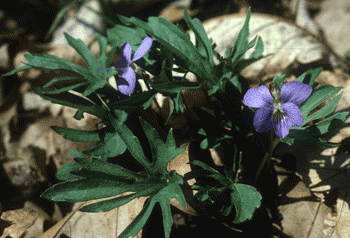 Family: Violet (Violaceace) Family: Violet (Violaceace)
Habitat: In nature it is found on rocky shales and mud stones from Maine to Florida. Will flourish in well drained garden soils that are not too fertile. They need full sun for vigorous growth .
Description: 3 to 5 inches tall, showy pansylike flowers. Color varies. In one variety two upper petals are royal purple, in others all petals are the same color. Named for its foliage which is palmately cut and resembles a birds foot. The showiest of our native violets.
Bloom period: Spring, May into June, in cultivation may bloom again in August until frost.
Culture: Look best when allowed to take over a sunny area. Birdfoot violets will selfsow on sandy soils.
Recommended selections: Viola pedata bicolor Purple-black upper petals. V. p. var. alba is a pure white form. V. pedatifida Prairie violet is easier to grow than birdfoot since it does not require acid soils.
Propagation: Plant nursery grown stock early spring or fall. Grows from bulblike roots which should be planted about 1 inch deep in sandy loam.
Back to List
10. Smooth Yellow Violet Viola pubescens Ait. var. scabriuscula Schwein. ex Torr. & Gray (Formerly V. eriocarpa syn Viola pennsylvanica) (VY-o-la)
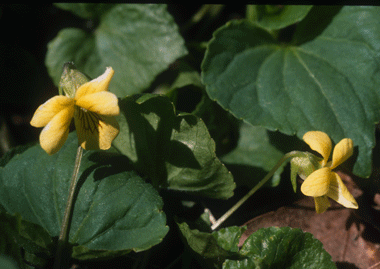 Family: Violet (Violaceae) Family: Violet (Violaceae)
Habitat: Rich humusy soil; Partial shade
Description: Yellow violet born of smooth stems, flower axial, height to 1 foot. Leaves heart shaped.
Bloom period: Spring into early summer
Culture: Want shade situation, but can withstand increased sun with a corresponding increase in moisture. Self-sows freely. Free blooming in shady situations.
Propagation By seeds for all species, division in species with multiple crowns or runners.
Back to List
11. Great Solomon's Seal Polygonatum commutatum
(po-lig-o-NAY-tum kom-mew-TAY-tum)
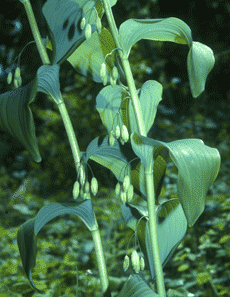 Family: Lily (Liliaceae) Family: Lily (Liliaceae)
Habitat: Rich, moist, humusy soil pH 4 -7 optimum 4.5 -5.5. Full to partial shade. Native to the eastern half of North America along streams and bottom lands.
Description: Clusters of 2-8 greenish-white bells born on single arching stems reaching 3 to 8 feet in length. Leaves on the upper 2/3rds of stalk. Bluish berries in fall.
Bloom period: June, persists about 2 weeks.
Culture: Requires a large shaded area, smaller species listed in related species. Plant for foliage, more than for flowers or berries which are not very showy. Use lots of humus when planting, and provide water. Often do not do well the first year following a transplant, hence wait until the second year before giving up. Forms dense clumps covering several square yards, makes a very effective background.
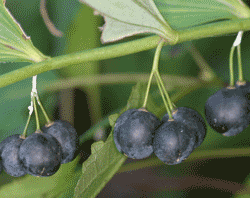 Recommended selections / related species: Smooth (small) Solomon Seal (P. biflorum ) is smaller rarely over 3 feet high, with flowers and berries born in clusters of two. P. pubescens, Hairy Solomon seal is similar to smooth, but its leaves are downy on their undersides. A Japanese Soloman's seal, P. odoratum 'Varegiegatum' with variegated leaves has become available through the horticultural trade.68 Recommended selections / related species: Smooth (small) Solomon Seal (P. biflorum ) is smaller rarely over 3 feet high, with flowers and berries born in clusters of two. P. pubescens, Hairy Solomon seal is similar to smooth, but its leaves are downy on their undersides. A Japanese Soloman's seal, P. odoratum 'Varegiegatum' with variegated leaves has become available through the horticultural trade.68
Propagation: By seed, or division of rhizome in early spring or fall when the plant is dormant. Remove seeds from mature fruits and plant 1/2" deep. Germination may take 2 years and 2-4 more years are required to reach flowering size.
Back to List
12. Solomon Plume or False Solomon Seal Smilacina racemosa
(sym-la-SY-na ras-em-MOH-suh)
Family: (Liliaceae)
Habitat: Native to thickets, moist woods and prairies. Rich, slightly acid, humusy soil, shade. From Quebec to British Columbia, south to Georgia and Arizona .
Description: Terminal cluster (hence name Plume) on an arching stem, 2 -3 feet in height at maturity. Stem zig-zags at each of its 5-12 lance-shaped leaves. White berries specked with red form by September.
Bloom period: Late Spring
Culture: Most effective in clumps of six or more stalks, at the base of trees, or as an accent in the woodland garden. Fall foliage is yellow before many of the other forest floor plants have turned.68 In a small garden choose over the Solomon's seals since it is more interesting (showy) while in flower. Does well in shade, hence under trees in the home garden. Multiplies through extension of its rhizome.
Recommended selections / related species: Starry Solomon plume (S. stellata) found over most of N. America and also native to Europe. Prefers a moister habitat than and will tolerate an acid or nearly neutral soil.
Propagation: By seeds, separated from the pulp and planted immediately. Seeds can also be cold stratified, but must be kept dark for light will inhibit their germination. Two years may be required for germination and 5 more before the plant is large enough to flower. Division of the rhizome in the spring. Allow a bud to remain on each section and plant horizontally a few inches below the surface.
Back to List
13. Foamflower Tiarella cordifolia (ty-a-REL-a kor-dif-FOH-lee-uh)
Family: Saxifrage (Saxifragiaceae) sax-if-rag-GAY-see-ee
Habitat: Rich, moist, humusy soil, cool shade. Native from Nova Scotia to Georgia and Alabama, found in the mountains and Piedmont provinces .
Description: Creeping plant 6-8 inches tall, with basal maple-like leaves with narrow spike like clusters of tiny fuzzy white or reddish flowers.
Bloom period: Spring with some flowers into early summer.
Culture: A good ground cover for a shady garden. Allow foamflower to form colonies in the woodland under deciduous trees or along paths. Does well set against old logs or boulders in a garden or at the base of a stone wall. It can be planted in containers provided that the roots are protected from freezing. It is attractive with ferns. As before this woodland plant will take more sun in the north than in the south. Three things are needed; 1. plenty of humus (peatmoss + leaf mold) 2. do not let it dry out and 3. protection from direct sunlight. It is a shallow rooted species therefore can be interplanted with deeper rooted species like Solomon's seal and cohosh. Mulch with shredded oak or bark.
Recommended selections / related species: T. wherryi does not spread by stolons, hence is easier to keep from spreading. If dead headed T.w. will bloom all season long.
Propagation: Seed in fall; division in spring. In damp rich soils it will send out many runners, which when rooted may easily be cut from the parent plant and replanted.
Back to List
14. Crested dwarf Iris Iris cristata (Iris kris-tay-TUM)
Family: Iris (Irridaceae)
Habitat: Rich rocky soils and along stream banks. Neutral to slightly acid soils of good fertility. Partial shade to full sun. A native from Maryland to Georgia .
Description: 3 to 8 inches tall, light blue to lavender-blue flowers with a yellow crest on each lower petal.
Bloom period: Late Spring for one or two weeks.
Culture: Will form ground cover in open shade, or sun if provided with moisture. A small slender rhizome, plant near surface with the tips partially exposed. If planting newly transplanted stock in full sun provide shade for seven to ten days. Foreground plantings for trees and flowering shrubs. Can also be used as a ground cover or edging plant. It combines nicely in southern rock gardens with fire pinks and green and gold. Its foliage can be highlighted with rock backgrounds.
Recommended selections: A white form —I. cristata 'alba' is also available. —I. versicolor - Blue flag Iris is a slow growing species that is also widely distributed over eastern north America.
Propagation: Divide plants in very early spring, or following blooming. All from rhizomes easily transplanted at any stage of growth. Propagation by seed can not always be counted on.
Back to List
15. Fringed polygala or Gaywings Polygala paucifolia (pol-LIG-uh-luh paw-sif-FOH-lee-uh)
Family: Milkwort Family (Polygalaceae)
Habitat: Rich dry acid to slightly acid soil pH 4.5 - 5. Woods, under trees where forest floor is free of grasses. Native New Brunswick to Saskatchewan south to Georgia .
Description: 3 to 5 inches tall, orchid like flowers from rose purple to magenta, rarely white. Few oval evergreen leaves take on a bronze cast in the fall.
Bloom period: Late Spring early Summer.
Culture: Hard to establish, but once established spreads well. Blooms early, hence does well when planted in a wildflower garden between taller later blooming species. In good sites it forms a low ground cover, and leaves may remain evergreen through winter. Should be planted in colonies or groups in the woodland. Slightly moist, but not wet humus-rich soil in some shade.
Propagation: In nature white stringlike rhizomes wander far from the plant, hence nursery grown stock is preferred. If gained through a plant rescue take large sections of sod. Once established in a garden it will spread both by roots, and by seed. Stem cuttings are best way of propagation.
Back to List
16. Cutleaved Toothwort or Crinkleroot, Dentaria laciniata (den-TAR-ee-a las-in-ee-AY-tuh)
Family: Mustard (Cruciferae)
Habitat: Rich damp woods and thickets along river bottoms in moderate shade .
Description: Pretty white or pink tinged flowers, 3/4 inch with 4 petals. Palmate leaves arranged midway on the 6-14 inch stem in whorls of three.
Bloom period: Early to mid Spring
Culture: Requires shade and moist rich soil. Does best when the soil is able to retain moisture during dry periods. For colonizing in woodland or shaded, informal rock garden.
Related species: D. diphylla Two-leaved toothwort, native to Nova Scotia to Carolinas, flowers white or pinkish on 8 - 12 inch stems.
Propagation: By seeds collected from the 1 inch narrow pods, or by root division. Place in a coldframe to overwinter.
Back to List
17. Bloodroot Sanguinaria canadensis (sang-gwi-NAR-ee-a)
Family: Poppy (Papaveraceae)
Habitat: Open woods (often Maple), with full to partial shade. Slightly acid soil pH 6-7. Native from New York and Wisconsin to Florida and Texas .
Description: Single leaves and flowers rise separately on big stems from rootstocks. Leaves enwrap the flower buds, fragile star-like blossoms of 8 white pinkish petals on a solitary stem. When open the blue-green leaves are 4-8" across, palmate and irregularly lobed. White upward facing flowers about 1" across. Rhizome contains a carmine colored juice which has a toxic alkaloid.
Bloom period: Late March to early April.
Culture: Need full sun in early spring, will tolerate full shade later in the season. Mulch and provide winter cover with decaying leaves. Can be established among ground covers. Colonies can be used as foreground for shrubs or along woodland paths. After flowering, leaves continue to develop forming a ground cover .
Recommended selections: 'Multiplex' has double petals that lack stamens. The double form was first found in Michigan, then taken to the Netherlands, it does not produce viable seed.
Propagation: Propagate from rhizome division making sure each portion has an eye. Use fresh seed that has not been allowed to dry out, dry seed may remain dormant for over a year. Moist cold treat the seeds for 2-3 months, it will take up to 3 years before they reach flowering size. Will self-sow, needs protection from mice.
Back to List
18. Woodland Jack-in-the-Pulpit Arisaema triphyllum (Ar-riss-SEEM-uh trye-FILL-um)
Family: Arum (Araceae)
Habitat: Slightly acid soils pH 5-6.5, wet ground and partial shade. Native from Nova Scotia to Florida
Description: One or two leaves with three leaflets from 6 to 36". Flower is large cylindrical brown striped hooded compound flower. The Jack is a central column - spadix - which bears male flowers towards the top and female flowers at the base. A fruit cluster of bright red berries matures by early fall.
Bloom period: May to June
Culture: Grows best in moist sandy locations that are seasonally wet. To produce the greatest number of berries, top dress with compost, for this plant changes sex with the quality of its environment. Following a good year, the plant produces a greater proportion of female flowers that will result in berries. Direct sunlight results in a lighter less attractive plant. Plant either in small colonies or for accents when planted singly in well chosen spots among ferns. Goes well with maidenhair fern especially in late summer and fall when the fruit is conspicuous against the fern fronds. Jack-in-the-Pulpit can be container grown and forced for midwinter. Place pot in a plastic bag in the refrigerator for 2-3 months, than place on a sunny windowsill.
Related species: A. pusillum, swamp jack-in-the-pulpit, grows to 1 foot, solitary leaf, pulpit nearly black, early summer blooms several weeks after woodland form. Found in swamps and mucky ground.
Propagation: From seed and root divisions. Collect fruit when berries are red, remove brown seeds from the pulp and plant them 1/2 inch deep where plants are to grow. Moist stratification 6-12 weeks below 40oF needed for germination. Flowers the second year. Note root divisions need to be done with care for the roots contain a toxin that causes an allergic reaction in some people.
Back to List
19. Pink Lady's Slipper Cypripedium acaule (Sip-rip-PEED-ee-um ak-KAW-lee)
Family: Orchid (Orchidaceae)
Habitat: Requires acid soils pH 4-4.5, tolerates dry to bogy soils .
Description: Leafless flower stalk arises from a pair of 4 to 5 inch basal leaves. 1 - 2" pink flower, resembling a puffy slipper.
Bloom period: Spring, flower is long lasting on the plant.
Culture: Protected in many states, should never be dug from the wild. It is difficult to grow having a fibrous root system that extends over one foot from the basal leaves. Most wild collected plants eventually fail.Suitable for large and small woodland gardens, but requires strongly acid soil, hence is not recommended for gardens - see below for alternatives.
Recommended selections: Yellow Lady-Slipper (C. calcelolus var. pubescens ) does well on well drained humusy soil in full shade. Yellow Ladies slippers are the easiest of the native orchids to grow. Var. C. parviflorum is better for northern areas.
Propagation: Purchase from a reputable commercial grower.
Back to List
20. Sharp-Lobed Hepatica Hepatica acutiloba (He-PAT-i-kuh ak-kew-til-LOH-buh)
Family: Buttercup (Ranunculaceae)
Habitat: Calcium rich woods pH 6-7.5. Native Maine and Quebec to Georgia .
Description: Leather like three lobed leaves 3 to 4 inches above the ground are source of the name "liverleaf". The flower is 1/2 to 1 inch across and composed of 5-18 petal-like sepals that range from pink to blue in color. Prominent yellow stamens provide an accent to the flower which is born singly on a fuzzy 4 to 6 inch stem.
Bloom period: Early spring among the first plants to bloom.
Culture: Need part shade and soil rich in organic matter. Best if planted where soil remains moist but not wet through out the summer. Flowers do not open on cloudy days.
Related species: H. americana = round-lobed hepatica also found in acid soil areas pH 5-6. Present along the coast.
Propagation: Divide roots into sections. From seed may take two years to bloom. The first year only 2 cotyledons appear in the summer, use a bag to catch the seed.
Back to List
21. Great White Trillium Trillium grandiflorum
Family: 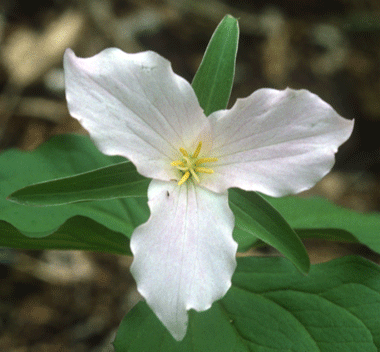 Lily (Liliaece) Lily (Liliaece)
Habitat: Rich, moist humus-filled soil, shade of deciduous or evergreen woods .
Description: Leaves and flower parts in threes. Vigorous plants approach two feet in height, with three ovate dark green leaves (2-6 inches) flowers in late April/May borne singly 3 sepals and 3 white petals to 3 inches across. Petals turn pink with pollination or age.
Bloom period: April.
Culture: Easily grown trillium. Long-lived and naturalizes well. Plant six inches deep in near neutral soil, sandy loams with thick humus layers are ideal. They need cold winters, hence may have troublEffectively displayed in mass plantings, or as accent. Will naturalize in improved soil. Can be interplanted with hepaticas, bloodroot, wild ginger or native ferns.e in regions milder than zone 7.
Related species: All worthy of cultivation.
Propagation Grow from fleshy roots or tubers late in the summer or early in the fall. Sow seeds immediately when ripe in sandy leaf mold, and keep moist. Dry seed will show impaired germination. Plants will bloom in 3 to 10 years depending on conditions. Wounding the rhizome will cause the formation of small bulblets along the damaged area. After 1 year these may be removed, and will produce blooming size plants in 1 to 2 years. Note this can be done without removing the plant from the soil, simply dig down to the plant and cut a v grove along the top of the rhizome.
Back to List
Selected Texts on Growing Wildflowers
Aiken, George. 1968 Pioneering with Wildflowers Prentice-Hall, Inc. New Jersey
Andrews, Jonathan 1987. The Country Diary Book of Creating a Wild Flower Garden Henery Holt and Company. New York
Art, Henery W. 1986. A Garden of Wildflowers. Garden Way Publishing
Art, Henery W. 1987. A Wildflower Gardener's Guide: Northeastern, Mid-Atlantic, Great lakes, and Eastern Canada Edition. Garden Way Publishing
Dietz, Marjorie 1965. The Concise Encyclopedia of Wild Flowers. Weathervane Books
Birdseye, Clarence & Eleanor. 1951, Growing Woodland Plants. Oxford University Press. Dover reprint 1972.
Bruce, Hal. 1976 How to Grow Wildflowers and Wild Shrubs and Trees in Your Own Garden. Alfred Knopf. New York
Ferreniea, Viki 1993. WIldflowers in Your Garden. A Regina Ryan Book; Random House New York
Miles, Bebe, 1976. Wildflower Perennials for Your Garden. Hawthror Books New York
Phillips, Harry. 1985 Growing and Propagating Wild Flowers. University of North Carolina Press. Chapel Hill
Sperka, Marie 1973 Growing Wildflowers A Gardeners Guide. Harper & Row Publishers New York
Steffek, Edwin 1983 The New Wild Flowers and How to Grow Them Timber Press Portland
Stokes, Donald and Lillian Stokes 1992. The Wildflower Book: East of the Rockies Little Brown and Company
Taylor, Kathryn, and Stephen Hamblin. 1963 Handbook of Wildflower Cultivation. MacMillan Company. New York. |
 Trilliums and Mitchella are adapted to grow in dense shade, others in very wet soils (Lobelia and Caltha), conditions that are worse than most plants would tolerate. Wildflowers grown within their natural habitat or native range are often fine tuned to climatic conditions, and will self-sow (Aquilegia).
Trilliums and Mitchella are adapted to grow in dense shade, others in very wet soils (Lobelia and Caltha), conditions that are worse than most plants would tolerate. Wildflowers grown within their natural habitat or native range are often fine tuned to climatic conditions, and will self-sow (Aquilegia). Outside of their habitat they behave as exotics and their culture is the same as other horticultural cultivars. Annual seed mixes may produce an attractive display in their first year. If components of the wildflower mix do not match local conditions some species will fail to set seed, and drop out of the mix in following years.
Outside of their habitat they behave as exotics and their culture is the same as other horticultural cultivars. Annual seed mixes may produce an attractive display in their first year. If components of the wildflower mix do not match local conditions some species will fail to set seed, and drop out of the mix in following years. Family: Buttercup (Ranunculaceae) (ran-nun-kew-LAY-see-ee)
Family: Buttercup (Ranunculaceae) (ran-nun-kew-LAY-see-ee)  Family: Buttercup (Ranunculaceae)
Family: Buttercup (Ranunculaceae)  Related species: caerulea = Colorado Columbine, native to the Rocky Mountains is blue-purple and white. —chrysantha = Golden Columbine, native to Texas is yellow. —jonesi is an alpine form from Montana and Wyoming with large blue flowers on short (3") plants.
Related species: caerulea = Colorado Columbine, native to the Rocky Mountains is blue-purple and white. —chrysantha = Golden Columbine, native to Texas is yellow. —jonesi is an alpine form from Montana and Wyoming with large blue flowers on short (3") plants. Wild Ginger Asarum canadense
Wild Ginger Asarum canadense Bloom Period: Spring
Bloom Period: Spring
 Family: Buttercup (Ranunculaceae).
Family: Buttercup (Ranunculaceae). Family: Daisy (Compositae)
Family: Daisy (Compositae)  Wild Oats, Sessile Leaved Bellwort Uvularia sessilifolia (u-vew-LAR-ee-a sess-il-if-FOH-lee-uh)
Wild Oats, Sessile Leaved Bellwort Uvularia sessilifolia (u-vew-LAR-ee-a sess-il-if-FOH-lee-uh)  Family: Violet (Violaceace)
Family: Violet (Violaceace) Family: Violet (Violaceae)
Family: Violet (Violaceae) Family: Lily (Liliaceae)
Family: Lily (Liliaceae) Recommended selections / related species: Smooth (small) Solomon Seal (P. biflorum ) is smaller rarely over 3 feet high, with flowers and berries born in clusters of two. P. pubescens, Hairy Solomon seal is similar to smooth, but its leaves are downy on their undersides. A Japanese Soloman's seal, P. odoratum 'Varegiegatum' with variegated leaves has become available through the horticultural trade.68
Recommended selections / related species: Smooth (small) Solomon Seal (P. biflorum ) is smaller rarely over 3 feet high, with flowers and berries born in clusters of two. P. pubescens, Hairy Solomon seal is similar to smooth, but its leaves are downy on their undersides. A Japanese Soloman's seal, P. odoratum 'Varegiegatum' with variegated leaves has become available through the horticultural trade.68 Lily (Liliaece)
Lily (Liliaece)